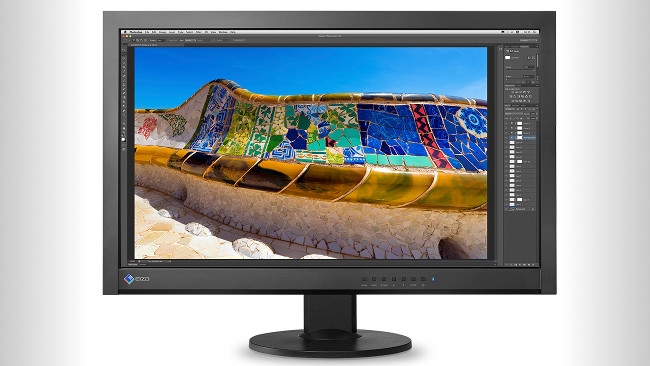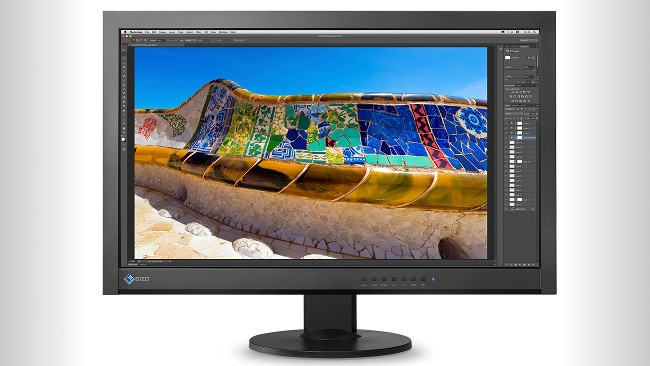
 EIZO ColorEdge CS270
EIZO ColorEdge CS270
A detailed look at the EIZO CS270, a 'cost-performance' colour management monitor that sports professional features and an appealing price tag. But does it make sense for video pros?
EIZO, well-known as monitor manufacturers for image, medical and business professionals, recently introduced a new entrant in its 'CS' series of 'cost-performance' colour management monitors, the ColorEdge CS270. The 27-inch WQHD monitor, aimed at "photo enthusiasts and graphics professionals," may also be an intriguing option for some video professionals, which is why we're reviewing it here.
Before I launch headlong into my impressions of the CS270, I first need to address its 'cost-performance' designation, to avoid any confusion. The CS270 is not a budget consumer product, so please erase any thoughts you might have of a bargain bin throw-in monitor that's typically bundled with low-end desktops. The CS270 is priced for the lower-end professional market, but sports a feature-set which presents a lot of value, assuming a workflow that fits within its capabilities.
Unboxing and prep
When the UPS guy handed me the boxed CS270, I was a little surprised by its weight. The CS270 may be the lightest 27-inch colour management monitor currently in EIZO's line-up, but its 23.4 lbs. (with stand) make it a hefty addition to your workspace (and that's likely where it will sit until it's time for an upgrade). Unboxing proceeded much like the unboxing of any monitor, replete with requisite manuals, stand, utility disk and cables, including the all-important Displayport cable, which is how you'll achieve the best image from this monitor (more on this later).
After consulting diagrammed instructions, the stand clicked into position. This is usually the point where I'd just hook up a monitor, but I thought it best to actually consult the quick start and set-up guides first, since this is a review. The included printed materials are simple and straightforward, but the full manual for the monitor and ColorNavigator calibration software resides on the utility CD. The manuals are rather lengthy, but you'll want to at least skim it, especially if this is your first colour management monitor. The manual gives you a window into the many varied colour and display options, which are major selling points for this product.
Features and performance
Upon reviewing the manuals and installing the ColorNavigator software, I hooked up the monitor to my PC via the Displayport connection of my GPU and set-up the monitor. There is a cool vertical height adjustment and 35-degrees of tilt, so the CS270 can find a home in your workspace no matter how unorthodox it may be. The ports on the back are oriented vertically, so instead of plugging in, you plug up, which seems a bit counterintuitive at first, but it makes cord wrangling a bit easier and the included plastic cord bracket also helps. The monitor supports portrait (i.e. vertical) mode, but was kept in the traditional landscape orientation throughout my time with it.
Before making any settings adjustments, it's recommended to leave the monitor on (i.e. displaying an image) for 30 minutes or so, to give the electronic components time to stabilize. Rushing to change settings before this burn-in period would result improper adjustments that would need to be set again. Yet, even before the burn-in, I was greeted with a beautiful displayed image that put my general purpose (i.e. consumer) HD monitor to shame.
It's not just a case of increased resolution (the C270's resolution is 2560 x 1440); the quality of the image, in terms of colour, contrast, brightness and uniformity across the display, immediately impresses. This is the first display in EIZO's 'cost/performance' line to reproduce 99% of the Adobe RGB colourspace. The C270 also supports an assortment of third-party display calibration hardware, controlled through the ColorNavigator software and USB connection. However, the CS270 lacks the built-in self-calibration hardware of EIZO's CG277, a higher-tier 27-inch monitor, so potential buyers will have to weigh the importance of that built-in feature in the CG277 (and a faster response time: 6ms against 15ms) versus the price savings offered by the CS270.
After burn-in, I took a tour of the image settings through the CS270's on-screen menu, which offers an array of options for fine-tuning the monitor and common presets. The presets may be fine for many users and the monitor comes with a pre-calibrated gamma curve from the factory, meant to provide a pleasing image from the start. However, in order to get the very best and most faithful image, you need to utilise the ColorNavigator software, in conjunction with a third-party hardware display calibration sensor. This is a topic that's bigger than the scope of this article, as the manual for ColorNavigator is double that of the actual monitor. But, for professional use, you should calibrate your monitor periodically, as performance changes with age. Thankfully, the CS270 with ColorNavigator has a timer function, alerting you when it's time to recalibrate.
As I mentioned previously, CS270 users should use the Displayport connection, if at all possible. While you can use DVI or HDMI ports, to display 10-bit colour with 1024 shades of tonality and, according to Eizo, billions of simultaneous colours, the Displayport is your only option. To be fair, whether connected through DVI, HDMI or Displayport, the image quality is excellent. Like its higher-end cousins, the CS270 packs proprietary hardware for image processing, backlit LEDs and digital uniformity equalizer (DUE), to compensate for brighter areas of the monitor. But, why on earth would you purchase a professional colour management monitor (even a lower-end professional monitor) and opt for connectivity that doesn't make the most of the display's ability? Do yourself a favor: just use the Displayport.
Conclusions
The real question isn't if the CS270 is a highly-capable monitor; it most obviously is. Other than the absent built-in hardware calibrator and lower power consumption and weight, the CS270 is nearly identical to the CG277, which we favorably reviewed earlier this year. The real question is one of suitability.
The retail price of $1153 likely puts it out of reach for many enthusiasts, but the price tag and what you get for it makes it an attractive option for photo editors, graphic artists and designers of all stripes, comprising a pretty wide market. But, for video professionals, suitability of the CS270 depends on whether you're finishing projects in 4K and above. While it may seem that the entire industry has moved to 4K, for most video professionals, 4K adoption will be based on need. In other words, if you don't anticipate a need in the next year or two to make the jump to 4K (because your clients aren't asking for it), then the CS270 offers great value for about half the cost of the higher-end CG277 WQHD display.
The CS270 is a wonderful, feature-packed display, ideal for video projects finishing in HD or WQHD. If you absolutely need 4K and professional features, EIZO has the CG318-4K, a 31-inch DCI monitor that will run you about $5900. Only a few short years ago, a monitor with the CS270's specs might have cost you as much as the CG318-4K does now. In another three-or-four years, the CG318-4K (or comparable monitor) might cost as little as the CS270 does now. However, EIZO is incentivizing purchase of the C270 with its Professional Photo Kit bundle, which includes the monitor, EX2 Sensor (EIZO Color Calibration Photo Meter), ColorNavigator 6 and 20% off a one year subscription to Adobe Creative Cloud Photography Plan.
In other words, the CS270 is an excellent choice and provides a lot of value for now, right now, but only if it makes sense for the work you do.
Tags: Technology


Comments